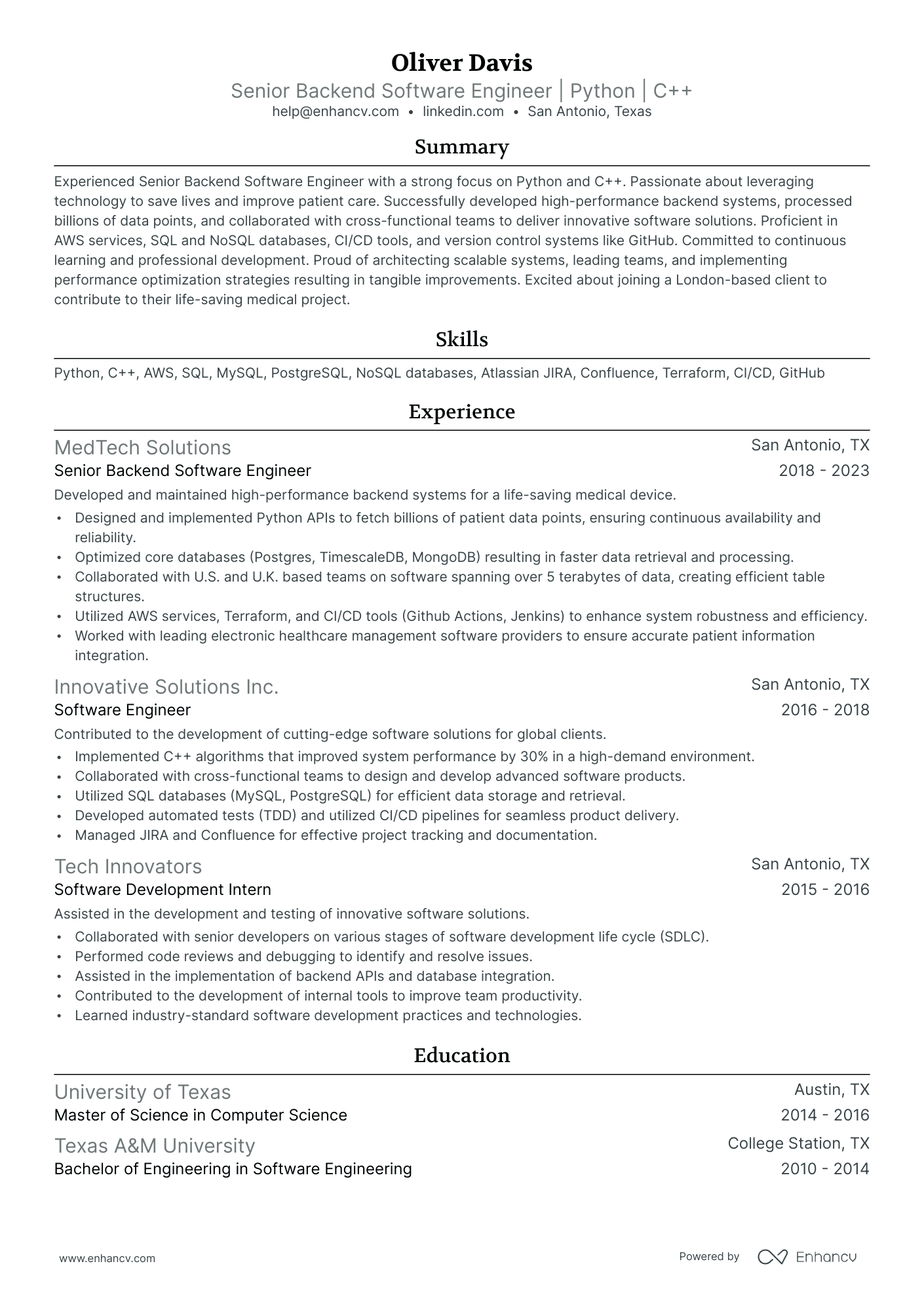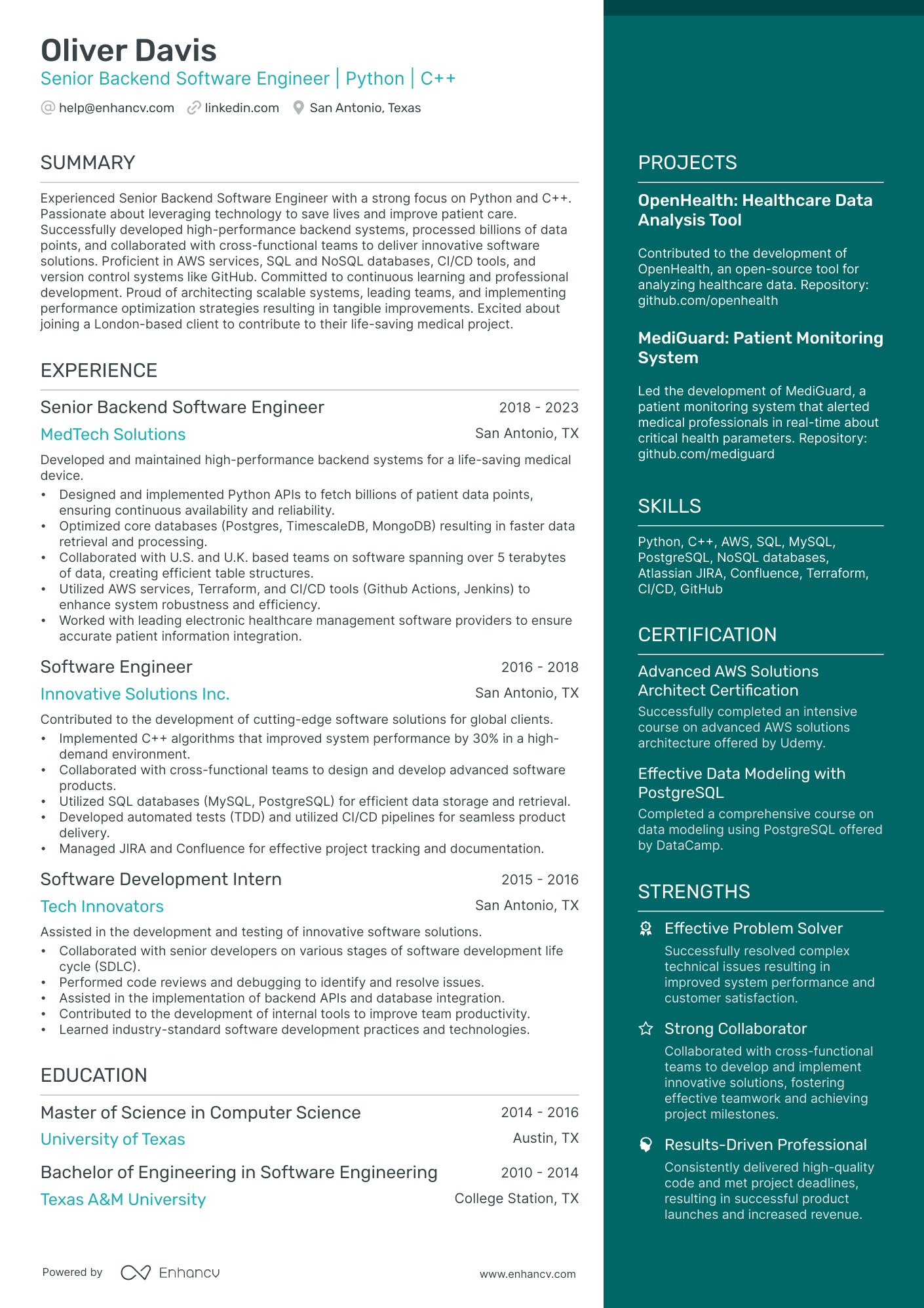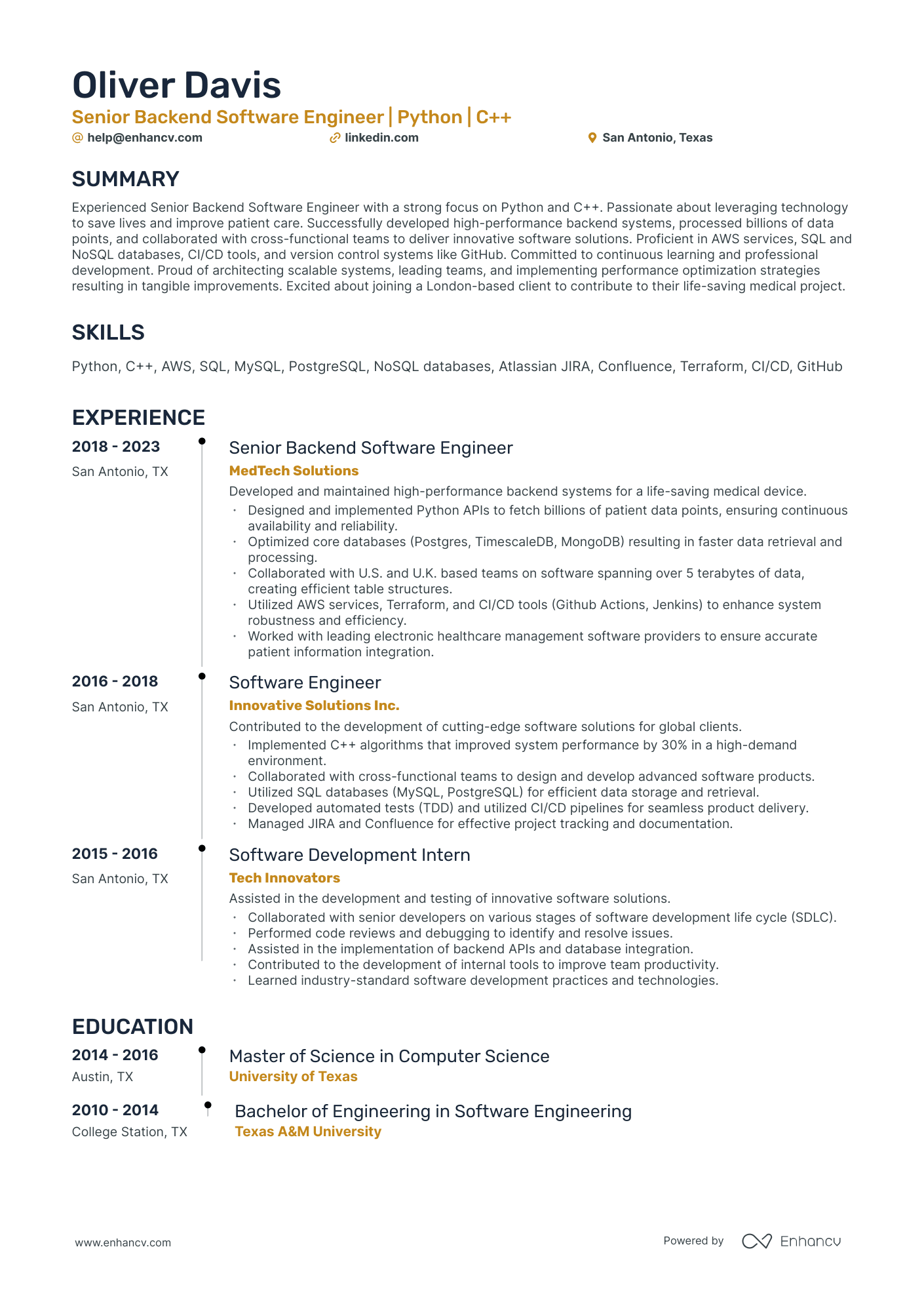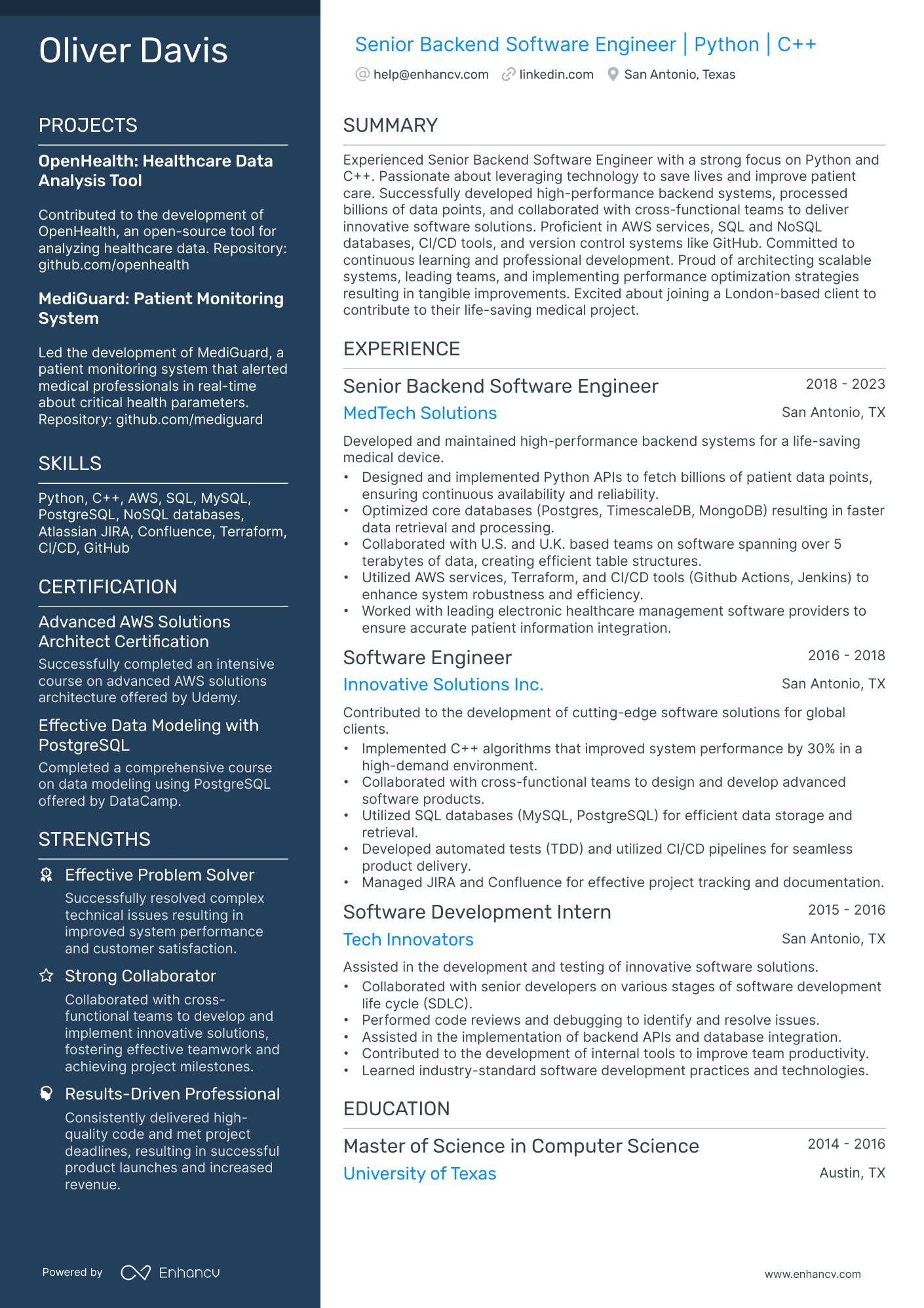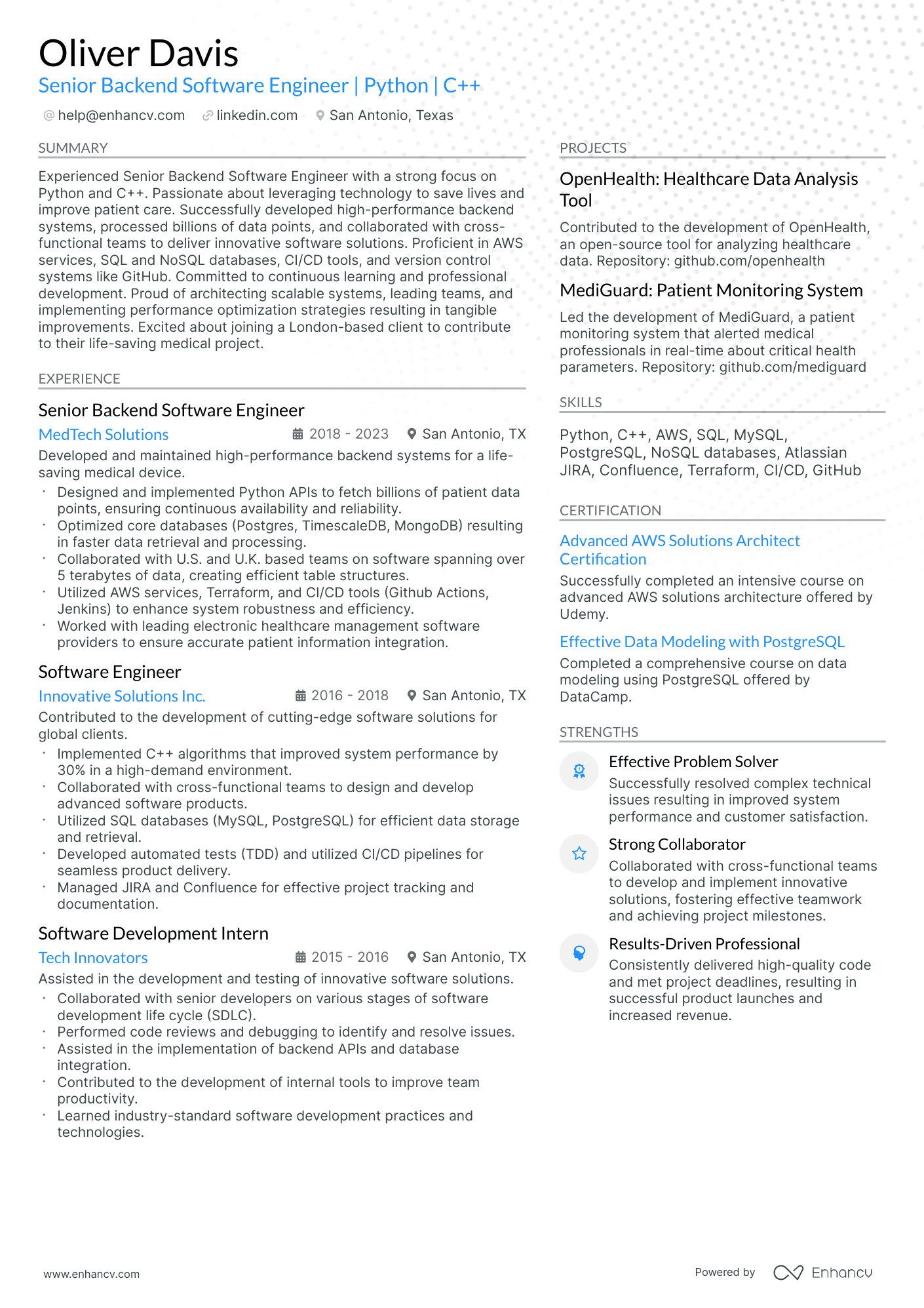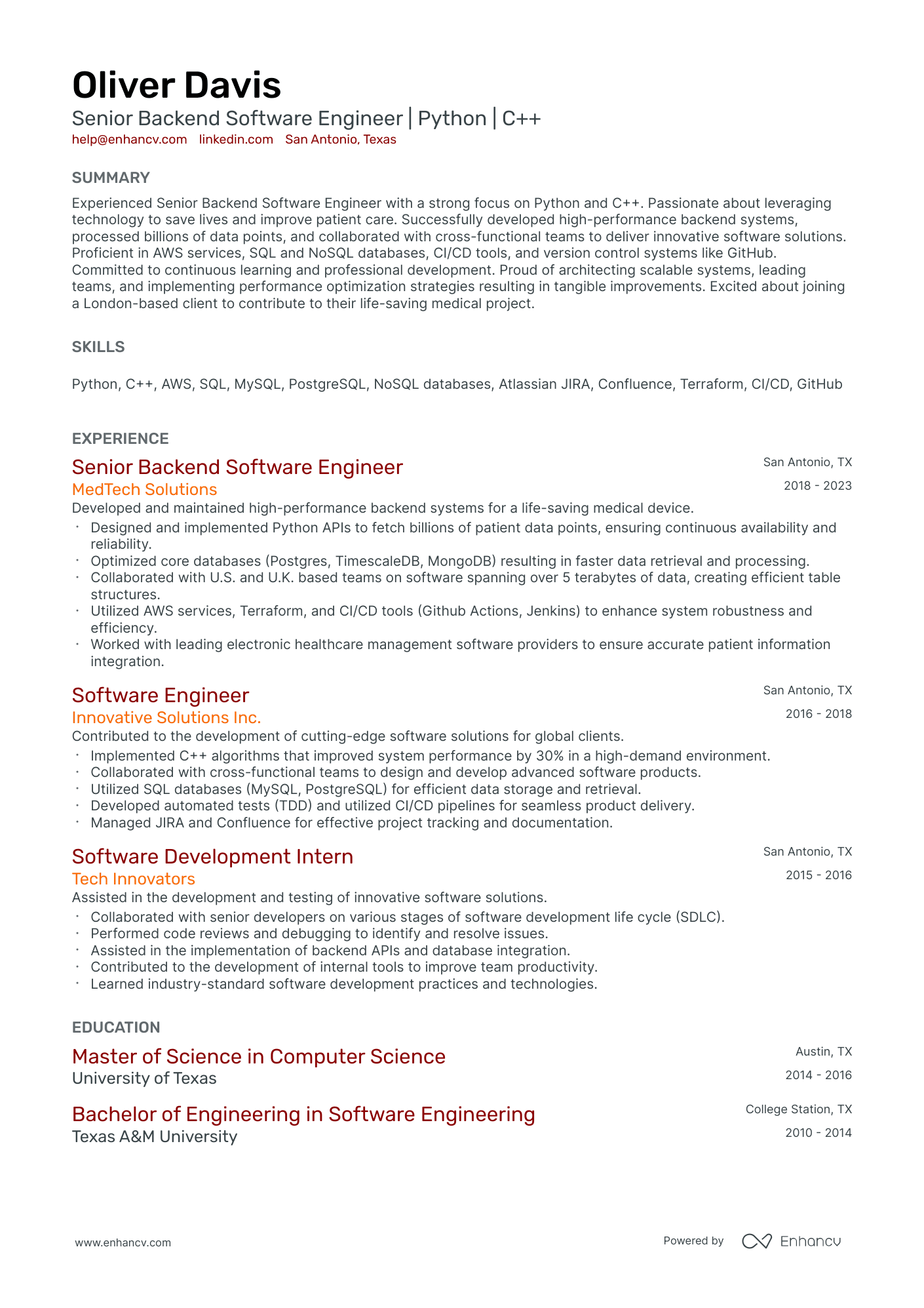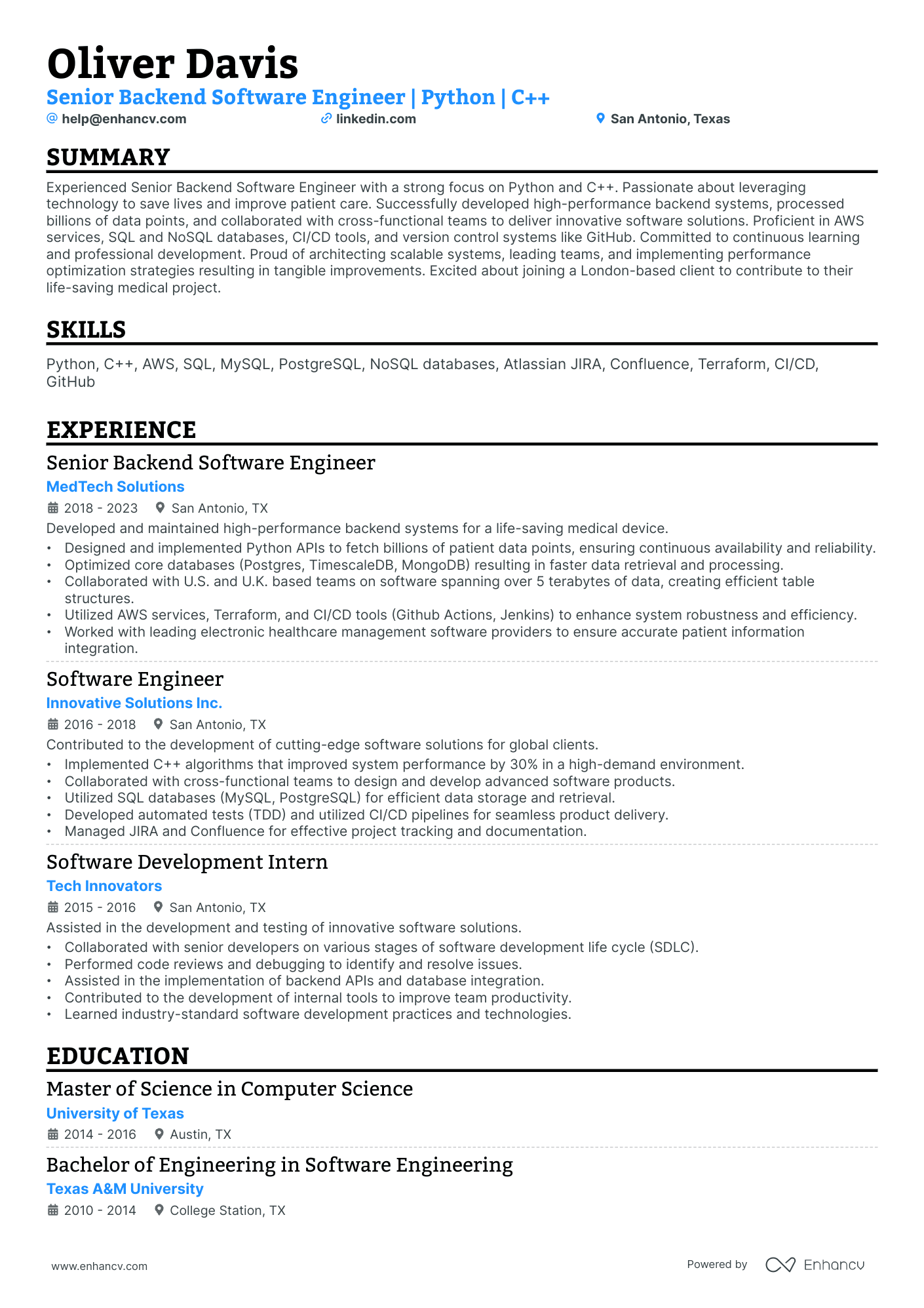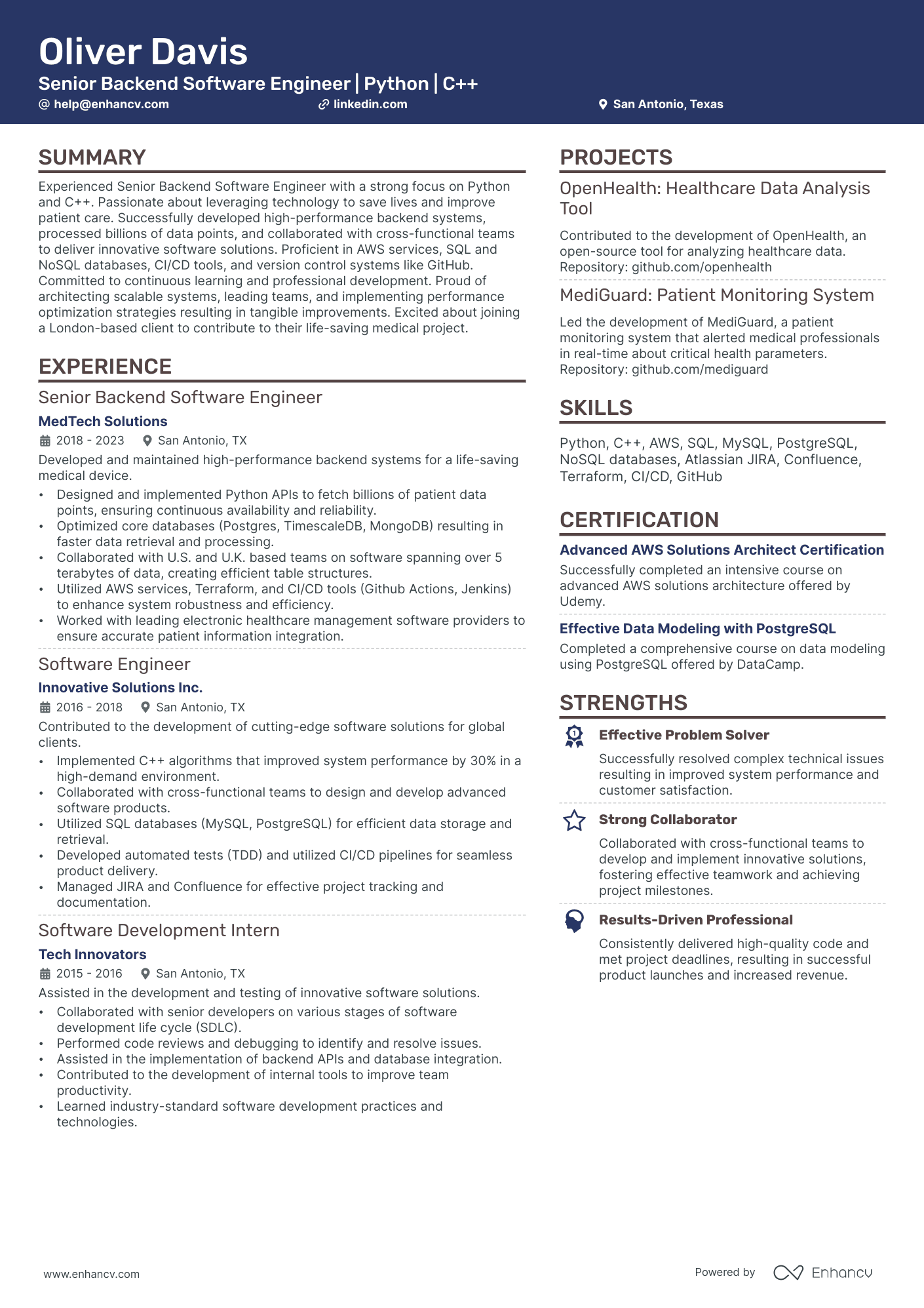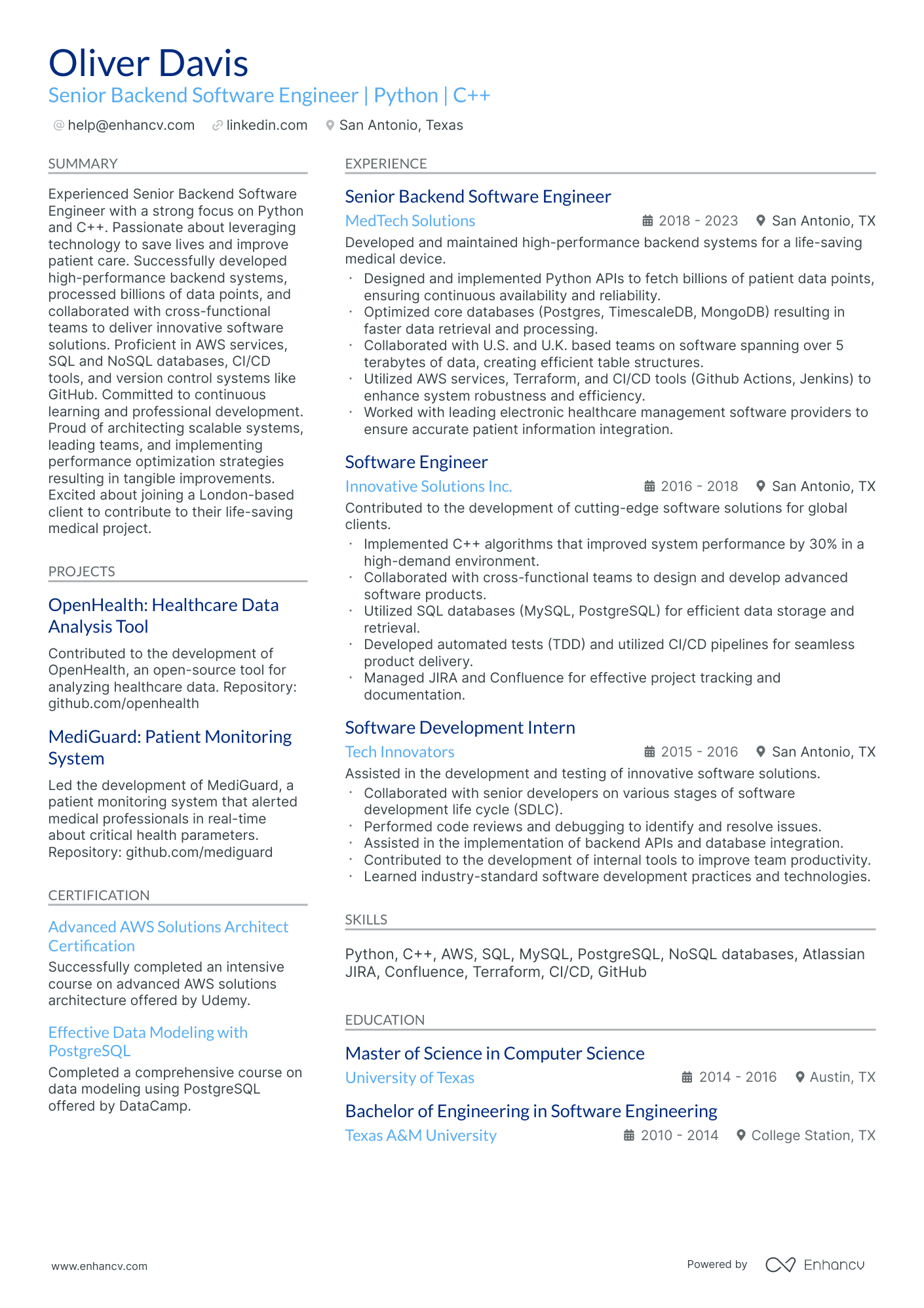Analytics engineers often struggle to convey their technical skills and experience in a manner that's understandable to non-technical recruiters or hiring managers. Our guide can assist by providing industry-specific terminology and examples of how to succinctly describe complex technical tasks, making your skills and experiences accessible and appealing to a broad range of readers.
Dive into our comprehensive guide to crafting a standout analytics engineer resume:
- Discover analytics engineer resume samples that have secured positions at top-tier companies.
- Master the aesthetics of your resume layout for maximum impact.
- Strategically present your achievements and skills across various resume sections.
- Convey to recruiters why you're the perfect fit for the job.
Recommended reads:
Demystifying the analytics engineer resume format
While a touch of creativity can be appealing, it's the clarity and relevance of your analytics engineer resume format that truly resonates with recruiters.
To ensure your resume not only captures attention but also maintains it, consider these four streamlined steps:
- If your career boasts a wealth of pertinent and recent accomplishments, the reverse-chronological resume format is your ally. It naturally emphasizes your experience, placing your most recent roles at the forefront.
- Design a straightforward header: incorporate your contact information, a headline reflecting the position you're vying for or your current designation, and a link to your professional portfolio.
- While brevity is key, if you're targeting a senior position or have accumulated over ten years of industry-relevant experience, extending your resume to two pages is permissible.
- To ensure consistent formatting across various platforms, always save and submit your analytics engineer resume as a PDF.
Consider your target market – resumes in Canada, for example, follow different layout conventions.
Upload your resume
Drop your resume here or choose a file. PDF & DOCX only. Max 2MB file size.
Pro tip
At the end of the day, recruiters care most about how easily they can scan and read your resume layout. Unless you're aiming for a role in a creative field, it might be best to stick with a straightforward layout and format. Instead, put your energy into showcasing your experience.
Key sections to include in your analytics engineer resume are:
- The header - with your contact details (like email and phone number), a link to your portfolio, and a headline.
- The summary (or objective) - highlighting the high points of your career so far.
- The experience section - limit yourself to six bullets per role to focus on specific results.
- The skills list - offering a balanced mix of your personal and professional talents.
- Education and certification - displaying your most relevant degrees and certificates for the analytics engineer role.
What recruiters want to see on your resume:
- Technical Skills: Familiarity with analytics tools and languages such as Python, R, SQL, and proficiency in data warehousing platforms like Redshift, Snowflake. Experience with ETL (Extract, Transform, Load) processes is also crucial.
- Data Visualization: Proficiency in data visualization tools like Tableau, Power BI, Looker that facilitate understanding and communicating insights from complex data sets.
- Statistical Analysis Skills: Knowledge of statistical analysis, predictive modeling, machine learning, and data mining techniques to interpret data and make recommendations.
- Experience in Database Management: Demonstrated experience in managing databases including designing, writing, and troubleshooting complex SQL queries.
- Problem-Solving Orientation: Evidence of strong problem-solving skills, particularly related to translating business problems into analytical frameworks and converting data-driven insights into decisions and actions.
Recommended reads:
Strategies for crafting your analytics engineer resume experience section
When detailing your analytics engineer resume experience, it's essential to pair responsibilities with tangible achievements.
Consider including:
- Key responsibilities, emphasizing their significance to your role, team, or organization.
- Experiences that have fostered your technical acumen or professional growth.
- Metrics that underscore your contributions and successes.
- Challenges you've addressed and the solutions you've implemented.
- Strategies you've devised and their measurable impact on growth.
Your experience section is pivotal in making a lasting impression on recruiters. To inspire you, we've curated real-world analytics engineer examples:
- Developed custom analytics solutions to optimize marketing campaigns resulting in a 20% increase in conversion rate.
- Collaborated with cross-functional teams to identify and address data quality issues, leading to a 30% improvement in data accuracy.
- Implemented advanced machine learning algorithms for predictive analytics, enabling proactive decision-making and reducing costs by 15%.
- Led the development of a scalable data infrastructure, processing terabytes of data daily, resulting in improved data accessibility and analysis.
- Designed and implemented real-time data pipelines and ETL processes, handling petabytes of data weekly.
- Developed data visualization dashboards using Tableau, providing actionable insights to senior management.
- Collaborated with data scientists to build and deploy machine learning models, improving customer segmentation accuracy by 25%.
- Optimized SQL queries and database performance, reducing query execution time by 40%.
- Led a team of analysts in conducting in-depth exploratory data analysis, identifying trends and patterns to drive business growth.
- Developed data-driven solutions for predictive maintenance, reducing equipment downtime by 30%.
- Collaborated with cross-functional teams to implement a data warehouse, enabling centralized data storage and efficient reporting.
- Built custom data analytics tools using Python and R, automating data processing tasks and saving 20% of manual effort.
- Conducted A/B tests to evaluate the impact of website changes, resulting in a 15% improvement in conversion rate.
- Provided ad-hoc data analysis support to various teams, driving data-informed decision-making.
- Designed and implemented a real-time fraud detection system, reducing fraudulent transactions by 25%.
- Developed anomaly detection algorithms to identify potential security threats, improving system security by 30%.
- Collaborated with data scientists to build recommendation systems, increasing customer engagement by 20%.
- Optimized distributed data processing workflows using Apache Spark, decreasing data processing time by 40%.
- Led cross-functional projects to integrate data from multiple sources, providing a comprehensive view of customer behavior.
- Developed statistical models for demand forecasting, resulting in a 10% reduction in inventory costs.
- Implemented data governance processes and policies, ensuring data integrity and compliance with regulatory requirements.
- Collaborated with business stakeholders to define key performance indicators (KPIs) and built automated reporting dashboards.
- Improved ETL processes, reducing data extraction time by 50%.
- Provided technical training to team members, enhancing their understanding of data analytics techniques.
- Developed scalable data processing pipelines using Hadoop, handling large volumes of data for analysis.
- Collaborated with data scientists to build predictive models for customer churn and upsell opportunities, resulting in a 15% increase in revenue.
- Designed and implemented data visualization dashboards using D3.js, enabling stakeholders to monitor key metrics in real-time.
- Optimized database performance by fine-tuning SQL queries and creating appropriate indexes, reducing query response time by 50%.
- Led the migration of on-premises analytics infrastructure to the cloud, improving scalability and reducing infrastructure costs.
- Developed and maintained scalable data pipelines using Apache Kafka and Apache Airflow, processing terabytes of data daily.
- Collaborated with business stakeholders to define analytics requirements and developed custom solutions to meet their needs.
- Implemented anomaly detection algorithms, identifying potential fraud cases and minimizing financial losses.
- Performed exploratory data analysis and built predictive models to optimize pricing strategies, resulting in a 10% increase in profit margin.
- Led a team of analysts in conducting market research and competitor analysis, providing insights for strategic decision-making.
- Built data infrastructure for real-time monitoring and analysis of user behavior, resulting in a 20% improvement in user engagement.
- Collaborated with data scientists to develop recommendation systems, increasing click-through rates by 15%.
- Implemented data privacy and security measures, ensuring compliance with industry regulations and protecting user data.
- Optimized distributed computing workflows using Apache Spark, reducing processing time by 40%.
- Led the development of data visualization dashboards using Tableau, enabling stakeholders to track key metrics effectively.
- Developed customer segmentation models using clustering algorithms, improving targeting accuracy by 30%.
- Collaborated with data scientists to build predictive models for demand forecasting, resulting in a 15% reduction in inventory costs.
- Analyzed web analytics data to identify opportunities for website optimization, leading to a 20% increase in conversion rate.
- Optimized SQL queries and database performance, reducing query execution time by 40%.
- Led a team of analysts in designing and implementing data governance processes, ensuring data quality and compliance.
- Developed scalable data processing pipelines using Apache Hadoop, enabling efficient analysis of large datasets.
- Collaborated with cross-functional teams to define key performance indicators (KPIs) and built automated reporting dashboards.
- Implemented machine learning algorithms for predictive modeling, improving customer retention by 15%.
- Designed and optimized relational databases to support analytical workflows, enhancing data accessibility and query performance.
- Led the migration of data infrastructure to cloud platforms, reducing maintenance costs and increasing scalability.
Quantifying impact on your resume
<ul>
No experience, no problem: writing your analytics engineer resume
You're set on the analytics engineer role of your dreams. Yet, you have little to no work experience . Here's how you can curate your resume to substitute your lack of experience:
- Don't list every single role you've had so far, but focus on the ones that align with the job you're applying for
- Include any valid experience in the field - whether it's a university research project, or a summer internship
- Highlight the soft skills you're bringing along - those that will have an added value to your application.
- Focus on your education and certifications, especially if they make sense for the role.
Recommended reads:
Pro tip
Ensure your analytics engineer experience descriptions resonate with both tech-savvy and non-tech audiences. Adopting a consistent format, such as task-action-result, can lend clarity and coherence to your experience section.
Highlighting your hard and soft skills on your analytics engineer resume
The skills section of your analytics engineer resume should showcase your capabilities that align with job requirements.
Your hard skills, or technical skills, demonstrate your proficiency with technological innovations and specific software. On the other hand, your soft skills illustrate how you'd excel in the workplace environment with personal attributes like resilience, negotiation, and organization.
For a well-rounded analytics engineer resume, it's essential to include both. Here's how to craft a standout skills section:
- Prioritize skills listed at the top of the job advert.
- Highlight unique skills you've honed over time.
- Choose soft skills that resonate with the company or department culture.
- Address essential job requirements by listing key skills for the analytics engineer role that haven't been mentioned elsewhere in your resume.
Check out our sample skill list for analytics engineer to get ideas on the most sought-after hard and soft skills in the industry.
Top skills for your analytics engineer resume:
SQL
Python
R
Tableau
Looker
Apache Airflow
dbt (data build tool)
ETL processes
Data Warehousing
BigQuery
Analytical Thinking
Problem Solving
Communication
Collaboration
Attention to Detail
Time Management
Adaptability
Critical Thinking
Creativity
Project Management
Pro tip
Double-check the spelling of all skills and tools on your resume. Remember, software like the Applicant Tracker System (ATS) scans for these details.
Detailing your education and top analytics engineer certifications on your resume
Your education section can reflect a variety of skills and experiences relevant to the position.
- List post-secondary qualifications, noting the institution and duration.
- If you're currently studying, mention your expected graduation date.
- Exclude qualifications unrelated to the role or industry.
- If relevant, delve into your educational background, especially if it was research-intensive.
Including both relevant education and certifications on your analytics engineer resume can set you apart. It not only showcases your qualifications but also your commitment to the profession.
When listing these on your analytics engineer resume, make sure to:
- Highlight degrees and certificates relevant to the role.
- Mention the awarding institution for credibility.
- Include the start and end dates, or if the education/certification is ongoing.
- If relevant, incorporate a few keywords from the job advert within the description of the certification or degree.
If you have additional certifications not directly related to the role, consider placing them towards the end of your resume. This way, they can be viewed as personal interests rather than core qualifications.
For a quick update, check out our list of popular analytics engineer certifications curated by the Enhancv team.
Best certifications to list on your resume
Pro tip
If a particular certification is highly valued in the industry or by the company, consider highlighting it in your resume's headline.
Recommended reads:
Deciding between a analytics engineer resume summary or objective
While some argue the resume summary or objective is outdated, these sections can effectively:
- Integrate pivotal analytics engineer keywords.
- Showcase your achievements.
- Clarify your motivation for applying.
The distinction lies in their focus:
- A resume objective emphasizes your career aspirations.
- A resume summary spotlights your career milestones.
Opt for a summary if you have a rich experience you wish to highlight immediately. Conversely, an objective can be ideal for those wanting to underscore their aspirations and soft skills.
For inspiration, we've curated samples from industry professionals to guide your resume summary or objective crafting:
Resume summary and objective examples for a analytics engineer resume
- Experienced analytics engineer with a track record of 7 years in leveraging advanced statistical methods to interpret complex data sets. Proficient in Python, SQL, and Tableau, with a noteworthy achievement of designing a real-time analytics system that increased operational efficiency by 30% at XYZ Corp.
- Demonstrating a 10-year expertise in analytics engineering, adept in R, SQL, and Power BI. Recognized for driving continuous improvement in data systems at ABC Inc., leading to a 25% increase in business performance metrics over a span of 2 years.
- As a seasoned Data Scientist transitioning into analytics engineering, I bring forth a robust 8-year experience in the data field. Skilled in Python, Machine Learning, and Big Data, I have championed a predictive analysis model for DEF Company, boosting sales predictions accuracy by 20%.
- Transitioning from a Software Development background, my 5 years of experience coupled with proficiency in Java, Python, and SQL position me well for an analytics engineering career. Notable accomplishment includes developing a highly efficient database optimization algorithm at GHI Solutions.
- A recent Computer Science graduate desiring to launch a career in analytics engineering. With a firm grasp of Python, R, and SQL, along with an academic project focused on data analysis and visualization, I aim to apply my skills to facilitate data-driven decision-making processes.
- Eager to embark on a journey as an analytics engineer, utilizing my master's degree in Statistics and competencies in R and Statistical Analysis. My goal is to utilize data to influence strategic decisions, backed by a strong academic foundation in data modeling and interpretation.
Four additional sections to consider for your analytics engineer resume
To give a fuller picture of who you are, consider adding these sections to your analytics engineer resume:
- Awards - to showcase your achievements.
- Interests - to share passions outside of work.
- Publications - to highlight your contributions to the field.
- Projects - to spotlight significant accomplishments, even those outside of traditional work settings.
Key takeaways
- Format your analytics engineer resume for clarity and coherence, ensuring it aligns with the role.
- Highlight key sections (header, summary/objective, experience, skills, certifications) within your analytics engineer resume.
- Quantify achievements and align them with skills and job requirements.
- Feature both technical and personal skills across your resume for a balanced portrayal.
